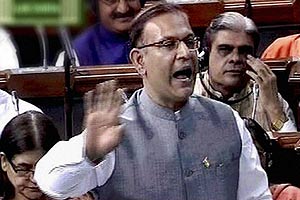A day after the Governor Raghuram Rajan-led Reserve Bank of India cut its key policy rate by 25 basis points, minister of state for finance Jayant Sinha expressed hope that a few major banks would soon lower their lending rates, which in turn would prompt smaller banks to follow suit and help in the transmission of the monetary policy.
“We have a very competitive financial services industry. Now that the Reserve Bank of India has cut rates by 50 basis points in total (in calendar 2015), I am sure that one or two or three of the major banks will go ahead and cut rates. Once they do that, then all others will have to cut rates,” he told The Indian Express, stressing that RBI rate cuts would feed through the banking system.
The issue of a reduction in lending rates by banks is also likely to be taken up by finance minister Arun Jaitley when he meets public sector bank chiefs. The meeting is likely to be scheduled next week for a quarterly performance review of state-owned lenders.
The Reserve Bank of India had on Wednesday cut the repo rate by 25 basis points, following up on a similar cut in January this year.
However, commercial banks have till now not chosen to pass on the rate cut to consumers, though they have said they would take an appropriate call later. Even in January, just three of the 45 banks in the country had lowered lending rates.
The issue was also raised by Reserve Bank of India Governor Raghuram Rajan, who announced that further monetary action would depend on a range of factors including incoming data such as that on easing of supply constraints, improved availability of key inputs as well as “the pass through of past rate cuts into lending rates”.
The RBI’s first bi-monthly monetary policy statement of 2015-16 is scheduled for April 7.
However, Sinha maintained that inflation would be the key driver behind any decisions by the RBI. “I am sure what has been expressed is a balanced view on multiple factors that drive inflation and inflation is in fact, under the monetary policy agreement that has been signed really the prime objective. All these factors drive inflation and so the RBI has to monitor those. So I don’t think anything fundamentally has changed,” he stressed. Industry too has been calling for lowering of rates to help in their investment plans while it would also help boost consumer demand.
The Reserve Bank of India and the finance ministry last month signed a monetary policy framework agreement under which the central bank’s monetary policy measures would be aimed with the target to keep retail inflation in check at 6 per cent by January 2016, and to 4 per cent from 2016-17 with a band of (+/-) 2 per cent.

